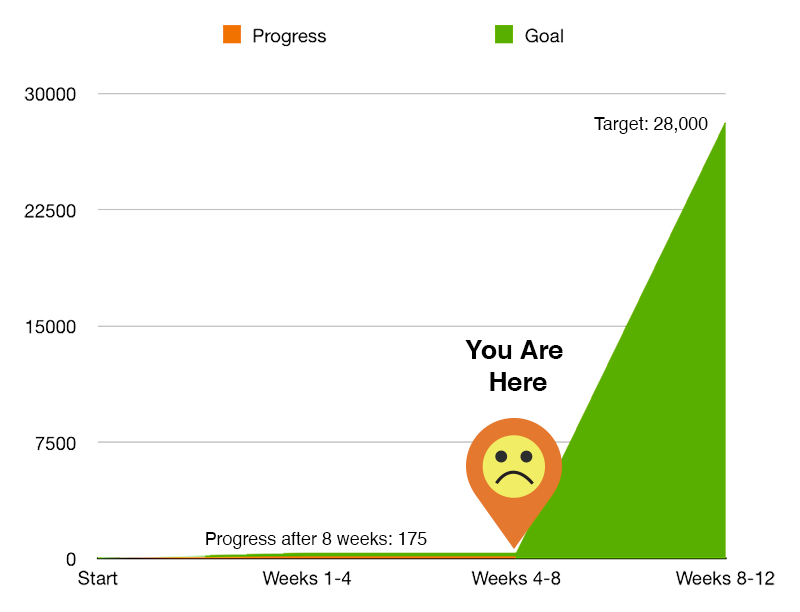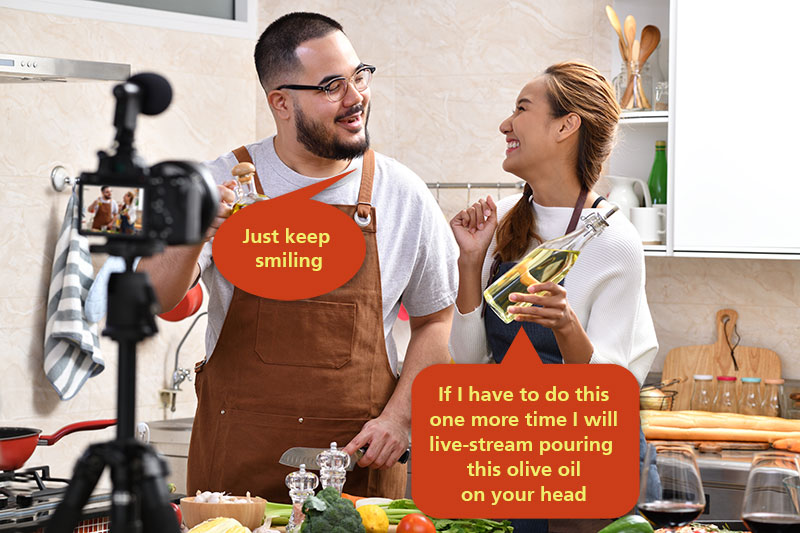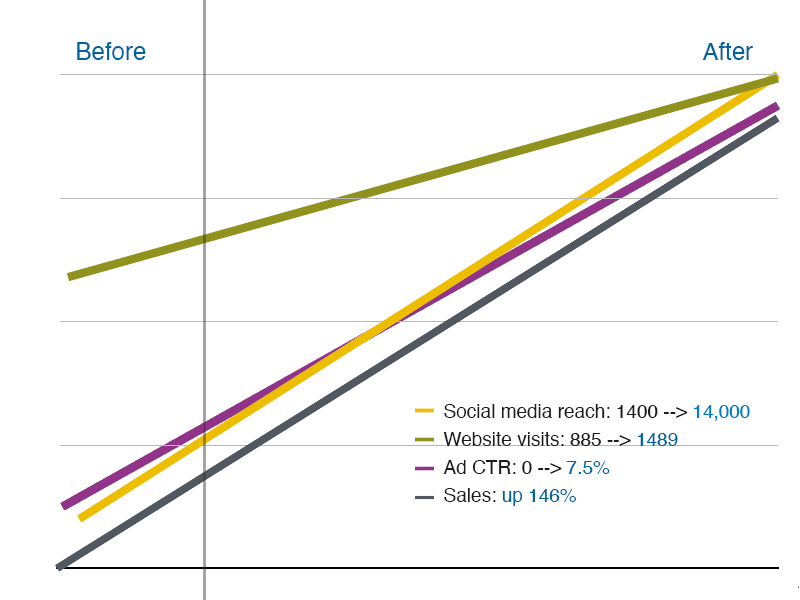Social media not working for you? Here’s how to fix it.
Three scenarios, three different circumstances, one shared problem: these social media campaigns need to go from useless to generating revenue in eight weeks or less.
Scenario 1: Your posts are ignored, your page feels abandoned
Before: Just 1400 page visits in more than three years.
After: 14,000 visitors, 7.5% CTR, 126% increase in sales.
You have a social media page that has all the charm and traffic of a backyard storage shed. Every once in a while someone from your organization tosses something onto it — another old photo, an inspirational poster, or a pillow embroidered with a meme — but nobody ever goes there with much anticipation or enthusiasm.
Now you’ve got a chance to generate some much-needed revenue and awareness from an upcoming event, and you need your social media to come alive. Can you go from dusty and forgotten to generating sales in a few weeks?
Scenario 2: Enthusiasm: Ten! Memes: Ten! Activity: Ten! Progress: Zero.
Before: Eight weeks of enthusiastic but aimless posting only ever reached the same 175 people. After: 28,000 targeted voters introduced to local candidate. Many of them donated actual money.

“Post every day!” they said. “Doesn’t matter what it is!” they said. “Cat memes are fine as long as you use your brand hashtags!” they said. They said other stuff, too, like, “Let the young people handle it!” And, “they don’t need direction; they live on social media!”
So now you’ve got a full portfolio of social media platforms, an energetic young crew regularly filling them with clever memes and hip references to your brand and pitch, and you’re on your way to reaching your target market of 28,000 people. Well, sort of on your way. A look at the metrics tells you that each post engages 175 people. On closer inspection, it turns out that it’s always the same 175 people, including your mom and your social media lead’s roommates. And while very supportive, they are not enough. The facts are that you’re 175 people down, 27,825 more to go, and you have six weeks left to meet your marketing targets.
Scenario 3: We’re In Content Hell.
Before: Two years of expensive and exhausting social media generated thousands of followers for a small business — but zero revenue.
After: Four new contracts signed in the first month, for a 400% ROI.

You engaged a professional firm to provide monthly social media services. It’s not very expensive each month, because your content, while customized with your logo and other brand cues, is lumped in with content created for other businesses in the same category. But it’s OK; you’re a business with a small service area and there’s no geographical overlap. The content skews a little off from your demographic and doesn’t truly communicate your USP,* but that’s OK; you’re pretty sure it’s close enough.
About six months in to your program, nothing much seems to be happening. The firm tells you to sweeten their mix with your own original content. They specifically recommend doing live-streaming video on a regular schedule. It’s hard to cram into your work week, but it’s OK, because the new content (yours, not theirs) seems to be working: after two years, you’ve gained lots of enthusiastic followers, especially for your videos, which are very popular, although exhausting to produce. Metrics for visitors, followers, and engagement are up by four figures.
Except…all this effort hasn’t gained you a single new customer or dollar of revenue. And when you dive into the stats you can see why: only 5% of all your enthusiastic new followers are even in your state, let alone within driving distance of your location. That budget that was so small one month at a time is a five-figure outlay after two years. This, you conclude, is definitely not OK, and you’ve decided you can only fund it for a few more weeks before you throw in the towel.
How to fix your social media
Can it be done? Yes — because it has. Each one of these scenarios is from a real project that we really turned around in a few weeks to meet or exceed objectives. And while the plan was different for each challenge, organization, and objective, the process is exactly the same. It doesn’t even matter what combinations of social media platforms you’re using — Facebook, Twitter, Instagram, LinkedIn, YouTube, TikTok — this formula will make it all work much better. As a bonus, it will be easier, because it’s always easier to start with a plan than to face the dreaded blank space of an empty post with no idea what to do next.
What you need is ICAR: Intent, the right Content, Targeted Ads, and Responsiveness
Intent
Why are you doing this?
Seriously, why?
Whether you’ve got five weeks or five hours, take a deep breath before you start and think about it. To be effective, social media ad campaigns need to be
- Planned
- Targeted
- Appropriate
Answering fundamental questions with specificity and thought is the first step to making it happen. Write down your objectives for the next few weeks. Figure out which segment of your target market will be most likely to respond. Think about what they want. Decide how to position what they want in a way that is appropriate to them, and to your brand.
Refer to your creative brief often during this process. What, you don’t have a creative brief? Now’s a good time to learn about them. I mean right now. Take ten minutes and go look. This page will be right here when you’re done.
Content
When it comes to content, all competent professionals are going to tell you the same thing: It needs to be
- Valuable
- Engaging
- Relevant
And I’ll add one more:
- Moving, sometimes. By which I mean that you include some content that’s moving. In other words, video.
What counts as valuable, engaging, and relevant content?
Content that is “valuable”, “engaging” and “relevant” is different for every audience, which is why “canned” content in a category often falls short of expectations. People who go to gyms, for example, are all seeking fitness, but there isn’t much else they share. Whether they’re women or men, young or mature, fit or struggling, busy or at leisure, social or solitary, budget-conscious or luxury-seeking, wanting the guidance of a trainer, or just looking for a quiet place to work out on their own are all factors that will make a big difference in what messages they consider valuable and relevant when seeking out a gym. When you’re specific in how you address it you’re more likely to get results.
Where do you get good content?
One place to start looking for that kind of content is the creative asset library you already have. (Or are building. Or plan to build. I’ll tell you how in a future post.) Mining images, copy, presentations and videos from your creative asset library saves time and money, and reinforces your message. But you have to choose the right mix of creative assets, and adapt it, enhance It, edit, update, and revise as needed for each objective and campaign. When in doubt, go back to your intent: what are you trying to do, and what does your audience want? Your choices are a lot clearer when viewed through that lens.
Another great source of content are answers to the questions that customers and prospects ask you. The very fact that someone asked about a topic is proof that the information is valuable and relevant to your target audience. If one person asked, it’s likely that 100 more are wondering. In fact, I suggest that clients save emails and messages with questions just to provide fodder for social media. Most of the posts on this website started out as a good question.
A Word About Video Content
Why video? That’s easy: For one, they are excellent ways to tell a story, and people like them. Videos are also fantastic for SEO. But except for all-video platforms (like YouTube and TikTok) that doesn’t mean that all of your content should include video. For most organizations just starting to build their content, or just starting the process or their content makeover, these guidelines work well:
- Start with a few videos, spread out across what you offer. For example, create one for each product or service line.
- Post videos that are relevant and useful, and that follow all the content guidelines described here.
- Don’t bother posting fluff. That video of your company party may be a lot of fun, but it’s not relevant to your business unless your business is planning parties.
- Make sure you optimize videos for SEO. The short version of how to do that is simple: when you upload a video to your video hosting platform of choice, fill in all of the boxes for title, description, etc. Is it a bit time-consuming? Yes! Does it mean you have to write a few paragraphs? Yes! Should you do it anyway? Yes!
- Track data to see which videos are performing best. Do more like those.
What’s wrong with memes, anyway?
There are a lot types of content that social media managers and content creators think of as easy fixes. They include memes, Throwback Thursdays, holiday posts that aren’t directly relevant to your products or services, quizzes, trivia, and more. Most of them are a waste of time, and they’re often not even that easy. Here’s why:
- Everyone does them, so you don’t stand out.
- People tend to remember the meme, not your brand.
- It’s hard to make them original, relevant, and memorable.
Here are a few ideas you should try instead:
- FAQs, as above.
- Tell a story (running themes that you can repeat are good)
- Testimonials
- Coupons, offers
- Product tips & tricks
Test as you go, and repeat what works best for your target audience and desired objectives.
Ads

- Ad budget
- Targeted audiences
- Affinity groups
A lot of companies expect their social media to drive traffic to their website. So it’s frustrating to learn that you have to first drive traffic to your social media. Most of the time, that means paid advertising, not boosting (we promise to someday write a long detailed post about why). The short version is that carefully placed paid ads are like personalized letters hand-delivered to the prospects you want most. Boosts are like dropping flyers over the whole neighborhood from a helicopter whose pilot may or may not have a decent sense of direction. There’s a reason boosts are so cheap; we’re just saying.
A good way to maximize your budget is to form partnerships with bigger pages that already have built a larger audience in your desired demographic. Owners of those pages will often have knowledge about the kinds of offers and content that will engage their audiences, and that can be extremely helpful. Partnerships in conjunction with paid placed advertising can really help you get your campaign off the ground and maximize your budget and reach.
How much would you spend on your social media ads? It depends. In Scenario 2, above, getting to 28,000 took several thousand dollars. In Scenario 1, with an excellent partnership, getting to 14,000 took just $450. In Scenario 3, re-vamped social media generated four new long-term customer contracts for the client in the first six weeks, with the same monthly budget as the generic-content provider had charged. (You may also need to budget something for planning and new content.)
Responsiveness
- Responding to engagement
- Measuring results and adjusting your campaigns by audience preference and behavior
When you’re used to getting little back from your social media efforts, it’s easy to forget that people might actually respond to it once you’re doing things differently. And it is, you know, a social medium. Each post is an invitation to conversation — that whole “engagement” thing. When someone responds to that post, talk back. Acknowledge what they said, amplify it, answer questions, offer take the conversation offline, invite them to discuss issues further. Even apologies, when offered promptly, honestly, and with redress, make a positive difference, not just to the person who complained, but to the social “neighbors” listening in. Most clients find that people who got a prompt and personal response are much more likely to become customers.
You should also be responsive to what your data tells you about your audience’s preferences. See what they like, and give them more of that. It might be a topic, an emotion, a format, or a product. Adjust your plans accordingly, because in the end, the only people who matter are the ones who will give you revenue.
Questions? Ask away in the comments, or shoot me an email, and I’ll be happy to answer them.
Learn more:
DON’T SIT IN THE MIDDLE! Quick Tip For Better Videos
How To Make A How-To Or Explainer Video
Can I Use AI For Writing Video Scripts?
*USP: Unique selling proposition. Your USP is what makes you different from your competitors, and what makes you uniquely qualified to meet the needs of your prospective customers.
Case Study Project Leads: Michelle LaPointe, Creative Direction. Becky Remy, Media Strategy & Management


